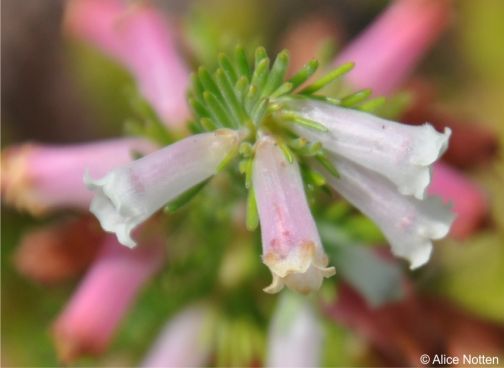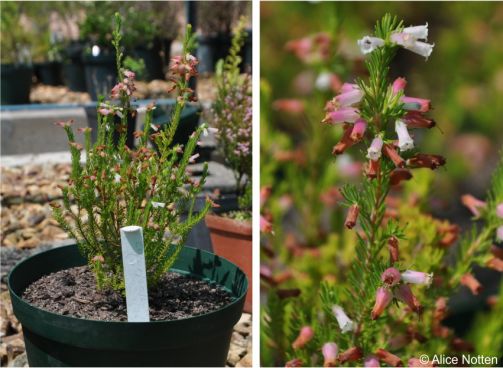Erica fontana
Erica fontana L.Bolus
Family: Ericaceae
Common names: fountain heath (Eng.); fonteinheide (Afr.)
Introduction
Erica fontana produces white to light rosy pink tubular flowers, that become paler towards the base, and the flowers appear all year round. It is a rare species that grows on marshy flats on the southern tip of the Cape Peninsula.

Description
Description
This upright evergreen shrub grows up to 1.8 m high. The branches are more closely grouped towards the upper part of the main stem. The tubular corolla (the inner covering of a flower) is 8 mm long but it can reach up to 10 mm and noticeably widens at the mouth. Visually this plant resembles Erica perspicua, the Prince of Wales heath, however, it is much lower growing. The anthers are included (do not protrude from the corolla) and muticous (without appendages). The flowers are borne more or less all year round, often with fresh and dead flowers on the plant at the same time.

Conservation Status
Status
The conservation status of Erica fontana is currently recorded as Rare, it is a range-restricted species, known from just a small area on the Cape Peninsula but there is currently no threat to the habitat of this species, as it is well conserved in the Cape of Good Hope section of the Table Mountain National Park.

Distribution and habitat
Distribution description
Erica fontana is found throughout the southern part of the Cape Peninsula, and is less localised than some of the other marsh dwellers. This plant grows happily in marshy flats near Paulsberg down to Olifantsbos and further south.
Derivation of name and historical aspects
History
Erica fontana belongs to the Ericaceae family. The heather or heath genus, Erica, comprises about 800 species and is found in Europe, the Mediterranean, the islands of the Atlantic and tropical Africa, however, it has its highest concentration of species in southern Africa where approximately 700 species are found, with over 600 species in the Cape Floristic Region alone.
The genus name Erica derives from the Latin word ereiko which means ‘heath’ or ‘broom’. The specific epithet derives from the Latin word fontanus which means ‘of a spring or fountain’ and refers to the plant's preference to grow in seepage areas or near water.

Ecology
Ecology
Erica fontana is a wetland species and often grows in seepage areas. This plant is a resprouter, which means that it regenerates successfully from the rootstock after a fire. In general, Erica flowers may be smooth, hairy or extremely sticky, which may serve as a protection feature for the plant. Erica fontana was observed being pollinated by insects, the insects visiting different flowers contribute to completing the pollination process.
Uses
Use
Erica fontana is best for fynbos gardens and may be grown as a pot plant provided that the potting medium used is in the acidic range, usually with a pH of 5.5 to 6.7, and the potting medium should not be allowed to dry out completely seeing that this is a plant that likes wet soil.

Growing Erica fontana
Grow
Erica fontana will grow happily in well-drained, moist, sandy soil conditions and at a pH of 5.5 to 6.7 in the garden and can be grown with other fynbos species that require similar conditions. E .fontana also requires a sunny position in the garden and good air circulation, so space plants adequately when planting. Ericas will struggle to grow in soil enriched with manure or with high lime concentration levels. Propagation from cuttings is more difficult and should be done with suitable facilities, such as mist propagation houses with heated benches and overhead misting. Propagate E .fontana by taking ±40-50 mm cuttings, thin side shoots (heel cuttings) for better results, preferably in autumn in the winter rainfall province Western Cape, but may also be taken in spring or early summer. Use a rooting medium of fine-milled bark and perlite balls at a 50:50 ratio to improve the chances of successful rooting.
Ericas are short-lived fynbos plants, the plant’s health declines rapidly after 10-15 years. Regular pruning will increase the life expectancy of the plants as well as flowering.
Use small pots, about 9 cm, for planting the rooted cuttings in. The potting mix consists of 7 parts milled bark and 3 parts sand. Feed the young plants with an organic liquid fertiliser, a fish emulsion type works well. Transplant well-rooted cuttings into half-litre bags for further root development, the young plants are usually ready to be planted within 3 to 4 months.
In South Africa, Western Cape Province, Erica seeds are best sown in autumn, in the months of April and May. Prepare 100 mm deep seed trays by filling them with equal parts of river sand and sifted composted bark. Treat seeds with the smoke from burning fynbos or smoke extract, this will improve the success rate of germination. Water the medium well after levelling, the levelling of the medium will ensure even germination of the seeds. Use fine river sand to mix with the seeds this will prevent the seeds from being sown too densely and thus reduce the chances of damping off. The seeds will show signs of germination after 4-8 weeks. Begin to transfer the seedlings as soon as they are about 10 mm high into small pots and be careful not to damage the fine hair-like roots.
Protect the young seedlings from heavy rainfall and direct sunlight, while still providing good light and aeration. The young plants are ready to be planted out in the garden when they are about 100 mm tall
Control fungal attacks on young plants by not sowing seeds too densely and maintaining good air circulation. Apply an appropriate organic contact or systemic pesticide to control mealybug and scale insects.
References
- Goldblatt, P. & Manning, J. 2000. Cape Plants. A conspectus of the Cape flora of South Africa. Strelitzia 9. National Botanical Institute, Pretoria & Missouri Botanical Garden, Missouri.
- Helme, N.A. & Trinder-Smith, T.H. 2006. The endemic flora of the Cape Peninsula, South Africa. South African Journal of Botany 72(2): 205–210.
- Hilton-Taylor, C. 1996. Red Data List of Southern African Plants. National Botanical Institute, Pretoria
- Inaturalist. Fountain Heath (Erica fontana L.Bolus). https://www.inaturalist.org/taxa/567384-Erica-fontana. Accessed 12/12/2023.
- Merry, C. 2015. Observation of Erica fontana, Cape of Good Hope Nature Reserve. iNaturalist. Online. https://www.inaturalist.org/observations/87553232.
- Pienaar, K. & Smith, G.F. 2011. The southern African what flower is that? An essential guide to garden plants. Struik, Cape Town.
- Schumann, D., Kirsten, G. & Oliver, E.G.H. 1992. Ericas of South Africa. Fernwood Press, Vlaeberg.
- Turner, R.C. 2007. Erica fontana L.Bolus. National Assessment: Red List of South African Plants version 2020.1. Accessed on 2023/11/17.
- World Flora online. Erica fontana L.Bolus. https://www.worldfloraonline.org/taxon/wfo-0000672086. Accessed 12/12/2023.
Credits
Benjamin Festus
Kirstenbosch National Botanical Garden
December 2023
Acknowledgements: The author thanks Alice Notten and Corinne Merry for providing the pictures.
Plant Attributes:
Plant Type: Shrub
SA Distribution: Western Cape
Soil type: Sandy
Flowering season: Sporadic/All year
PH: Acid
Flower colour: White, Pink
Aspect: Full Sun
Gardening skill: Average
Special Features:
Horticultural zones








Rate this article
Article well written and informative
Rate this plant
Is this an interesting plant?
Login to add your Comment
Back to topNot registered yet? Click here to register.